Synthetic Gypsum Market
Synthetic Gypsum Market Size and Share Forecast Outlook 2025 to 2035
Synthetic gypsum market is projected to grow from USD 2.1 billion in 2025 to USD 3.2 billion by 2035, at a CAGR of 4.3%. FGD Gypsum will dominate with a 37.0% market share, while drywall will lead the application segment with a 41.0% share.
Synthetic Gypsum Market Forecast and Outlook 2025 to 2035
The global synthetic gypsum market is projected to grow from USD 2.1 billion in 2025 to approximately USD 3.2 billion by 2035, recording an extraordinary absolute increase of USD 1.1 billion over the forecast period. This translates into a total growth of 50.5%, with the market forecast to expand at a compound annual growth rate (CAGR) of 4.3% between 2025 and 2035.
Synthetic gypsum demand is expected to grow by over 1.5X during this period, supported by exponential demand for sustainable construction materials, rising adoption of flue gas desulfurization technologies in power generation facilities, and growing emphasis on circular economy principles and industrial waste valorization across global construction and cement manufacturing operations.
Quick Stats on Synthetic Gypsum Market
- Synthetic Gypsum Market Value (2025): USD 2.1 billion
- Synthetic Gypsum Market Forecast Value (2035): USD 3.2 billion
- Synthetic Gypsum Market Forecast CAGR (2025 to 2035): 4.3%
- Leading Product Type in Synthetic Gypsum Market: FGD Gypsum (37.0%)
- Leading Application in Synthetic Gypsum Market: Drywall (41.0%)
- Key Growth Regions in Synthetic Gypsum Market: Asia Pacific, North America, and Europe
- Key Players in Synthetic Gypsum Market: USG Corporation, Knauf Group, American Gypsum Company LLC, Saint-Gobain, National Gypsum Company, BNBM Group, Georgia-Pacific Gypsum LLC, Dolina Nidy Sp.z.o.o, Yoshino Gypsum Co. Ltd., Etex Group
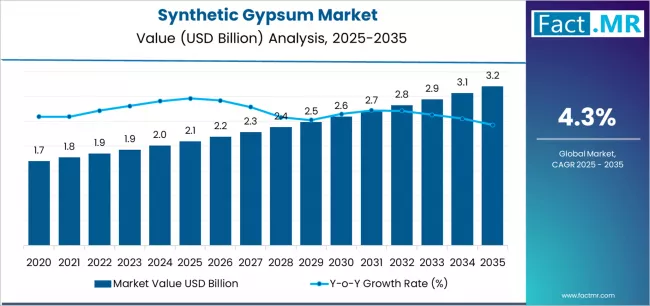
The synthetic gypsum market is positioned for substantial expansion, driven by increasing recognition of environmental sustainability importance, growing construction industry demand with enhanced green building standards, and rising adoption of waste-to-resource conversion technologies across industrial manufacturing practices globally.
The synthetic gypsum market demonstrates robust fundamentals supported by expanding FGD system installations in coal-fired power plants, construction industry professionals' focus on sustainable building material procurement, and rising recognition of synthetic gypsum as a critical resource in achieving enhanced environmental performance, cost optimization capabilities, and material quality consistency within modern construction architectures across diverse building applications.
Increase in synthetic gypsum demand is underpinned by technological innovations in gypsum recovery and processing procedures, particularly advanced desulfurization techniques and purification system integration, which offer enhanced material quality, improved production efficiency, and superior compatibility with comprehensive construction material protocols prevalent in contemporary building practices.
Construction material manufacturers increasingly prioritize synthetic gypsum sources that deliver optimal balance between performance reliability, environmental sustainability, and cost-effectiveness while adhering to increasingly stringent building standards and construction material requirements across global construction markets.
The convergence of power generation infrastructure expansion in emerging economies, construction industry growth in developed markets, and environmental regulation advancement creates multifaceted growth opportunities for synthetic gypsum producers and construction material supply chain operators.
The synthetic gypsum landscape is experiencing transformative changes as manufacturers adopt sophisticated recovery equipment including advanced scrubber systems, enhanced crystallization technologies, and automated quality control systems that enable consistent material properties and optimized production planning.
These technological advancements are complemented by evolving processing capabilities encompassing purification enhancement, moisture content optimization, and particle size distribution control that significantly improve material performance and application versatility.
The integration of supply chain management platforms and quality assurance systems further expands synthetic gypsum market penetration, particularly benefiting construction material manufacturers and cement producers where consistent material specifications remain critical for product quality assurance.
Between 2025 and 2030, the synthetic gypsum market is projected to expand from USD 2.1 billion to USD 2.6 billion, demonstrating strong foundational growth driven by global environmental regulation implementation, increasing adoption of FGD technologies in power generation facilities, and initial deployment of advanced gypsum recovery systems across industrial manufacturing platforms. This growth phase establishes market infrastructure, validates sustainable material sourcing protocols, and creates comprehensive supply networks supporting global construction and cement production operations.
From 2030 to 2035, the market is forecast to reach USD 3.2 billion, driven by mature FGD system penetration, next-generation recovery technologies requiring sophisticated processing expertise, and comprehensive integration of quality assurance systems demanding enhanced material consistency. The growing adoption of circular economy principles, green building certification programs, and construction material sustainability requirements will drive demand for comprehensive synthetic gypsum solutions with enhanced environmental credentials and seamless construction supply chain integration functionality.
Synthetic Gypsum Market Key Takeaways
| Metric | Value |
|---|---|
| Estimated Value (2025E) | USD 2.1 billion |
| Forecast Value (2035F) | USD 3.2 billion |
| Forecast CAGR (2025 to 2035) | 4.3% |
Why is the Synthetic Gypsum Market Growing?
Market expansion is being supported by the exponential increase in environmental sustainability requirements and the corresponding need for waste valorization solutions in industrial applications across global manufacturing operations. Construction material manufacturers are increasingly focused on synthetic gypsum sources that can improve environmental performance, enhance material consistency, and optimize production costs while meeting stringent regulatory requirements.
The proven efficacy of synthetic gypsum in various construction applications makes it an essential component of comprehensive sustainable building material strategies and green construction programs. The growing emphasis on environmental regulations and circular economy integration is driving demand for synthetic gypsum products that meet stringent performance specifications and operational requirements for construction applications.
Construction material manufacturers' preference for reliable, high-quality material sources that can ensure consistent product outcomes is creating opportunities for innovative recovery techniques and customized processing solutions. The rising influence of green building standards and environmental compliance regulations is also contributing to increased adoption of premium-grade synthetic gypsum across different construction categories and manufacturing systems requiring sustainable material technology.
Opportunity Pathways - Synthetic Gypsum Market
The synthetic gypsum market represents a transformative growth opportunity, expanding from USD 2.1 billion in 2025 to USD 3.2 billion by 2035 at a 4.3% CAGR. As construction industry professionals prioritize sustainability optimization, resource efficiency, and material consistency in complex manufacturing environments, synthetic gypsum has evolved from an alternative material to an essential resource enabling waste reduction, environmental compliance, and cost-effective production operations across construction and cement manufacturing platforms.
The convergence of environmental regulation acceleration, increasing FGD system penetration, advanced processing technology integration, and stringent sustainability mandates creates momentum in demand. High-purity FGD gypsum offering superior material properties, cost-effective recovery solutions balancing functionality with economics, and specialized applications for drywall manufacturing will capture market premiums, while geographic expansion into high-growth Asian construction markets and emerging industrial ecosystems will drive volume leadership. Construction material manufacturer emphasis on sustainability and material reliability provides structural support.
- Pathway A - FGD Gypsum Product Dominance: Leading with 37.0% market share, FGD gypsum applications drive primary demand through comprehensive power generation desulfurization workflows requiring high-quality material recovery for construction applications. Advanced recovery protocols enabling improved purity levels, consistent material properties, and enhanced processing efficiency command premium positioning from construction manufacturers requiring stringent performance specifications and regulatory compliance. Expected revenue pool: USD 0.8-1.2 billion.
- Pathway B - Drywall Application Leadership: Dominating with 41.0% market share through optimal balance of construction demand and material performance requirements, drywall applications serve most synthetic gypsum utilization while meeting diverse manufacturing demands. This application addresses both residential construction and commercial building expectations, making it the preferred category for construction material manufacturers and wallboard producers seeking comprehensive material capabilities. Opportunity: USD 0.9-1.3 billion.
- Pathway C - Asian Market Acceleration: China (5.5% CAGR) and India (5.2% CAGR) lead global growth through construction industry expansion, power generation infrastructure development, and environmental regulation advancement. Strategic partnerships with local construction material manufacturers, processing localization expertise, and supply network optimization enable the expansion of synthetic gypsum utilization in major construction and industrial hubs. Geographic expansion upside: USD 0.4-0.7 billion.
- Pathway D - Fluorogypsum Product Segment: Fluorogypsum with 24.0% market share serves critical industrial applications requiring specialized material properties for diverse construction operations. Optimized processing protocols supporting multiple application requirements, quality specifications, and proven material effectiveness maintain significant volumes from construction manufacturers and specialized product facilities. Revenue potential: USD 0.5-0.8 billion.
- Pathway E - Advanced Processing Technologies & Quality Enhancement: Companies investing in sophisticated purification techniques, crystallization optimization, and advanced quality control systems gain competitive advantages through consistent material delivery and performance reliability. Advanced capabilities enabling customized material specifications and rapid product development capture premium construction partnerships. Technology premium: USD 0.3-0.5 billion.
- Pathway F - Supply Chain Optimization & Material Consistency: Integrated recovery facilities, strategic processing partnerships, and reliable material delivery systems create competitive differentiation in construction markets requiring consistent synthetic gypsum availability. Companies offering guaranteed material quality, technical support services, and logistics optimization gain preferred supplier status with quality-focused construction material operators. Supply network value: USD 0.3-0.4 billion.
- Pathway G - Emerging Applications & Market Development: Beyond traditional drywall applications, synthetic gypsum in soil amendment programs, specialized cement formulations, and agricultural applications represent growth opportunities. Companies developing new processing protocols, supporting innovation initiatives, and expanding into adjacent construction materials and industrial markets capture incremental demand while diversifying revenue streams. Emerging opportunity: USD 0.2-0.3 billion.
Segmental Analysis
The market is segmented by product type, application, and region. By product type, the market is divided into FGD gypsum, fluorogypsum, phosphogypsum, citrogypsum, and others. Based on application, the market is categorized into drywall, cement, soil amendments, and others. Regionally, the market is divided into Asia Pacific, North America, Europe, Latin America, and Middle East & Africa.
Which Product Type Category enjoys the Dominant Position in the Synthetic Gypsum Market?
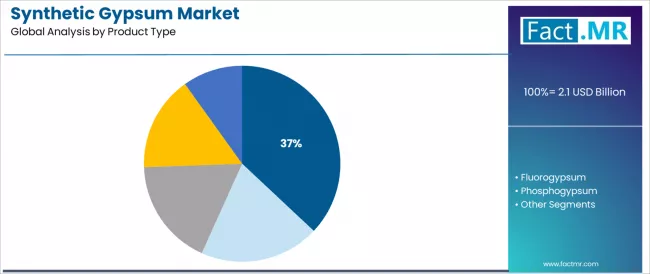
FGD gypsum is projected to account for 37.0% of the synthetic gypsum market in 2025, reaffirming its position as the category's dominant product type specification. Construction material manufacturers increasingly recognize the optimal balance of material quality and production economics offered by FGD gypsum for building product applications, particularly in drywall manufacturing operations and wallboard production environments.
This product category addresses both material performance requirements and environmental compliance demands while providing reliable quality outcomes across diverse construction applications. This segment forms the foundation of most sustainable construction material protocols for building manufacturing and industrial production, as it represents the most economically significant and commercially established product category in the synthetic gypsum industry.
Material quality standards and extensive application validation continue to strengthen confidence in FGD gypsum among construction manufacturers and building material professionals. With increasing recognition of FGD gypsum's impact on environmental performance and material consistency requirements, FGD gypsum sources align with both current construction practices and sustainability evolution goals, making them the central growth driver of comprehensive green building strategies across multiple construction platforms.
Fluorogypsum represents 24.0% of product applications, reflecting the significant industrial recovery capabilities and specialized material properties. Phosphogypsum accounts for 18.0% of the segment, driven by phosphate fertilizer production operations requiring efficient byproduct management protocols. Citrogypsum operations represent 10.0% of product types, while other synthetic gypsum categories account for 11.0%, encompassing specialized industrial applications including titanium dioxide production, chemical manufacturing, and other industrial processes requiring targeted gypsum recovery.
Why do Drywall Applications command the Majority Market Share?
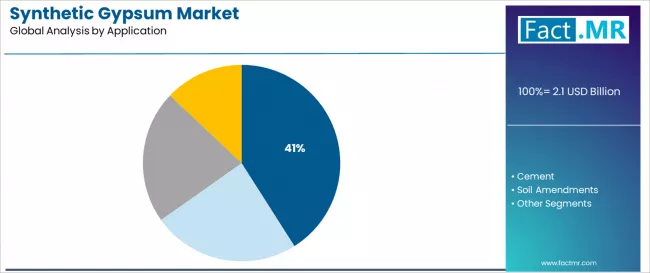
Drywall applications are projected to represent 41.0% of synthetic gypsum demand in 2025, underscoring its role as the primary application category driving market adoption and material utilization. Construction material manufacturers recognize that drywall requirements, including diverse wallboard specifications, varied building applications, and comprehensive construction protocols, provide the largest addressable market that other applications cannot match in volume scale and material consumption.
Drywall applications utilizing synthetic gypsum offer enhanced sustainability credentials and consistent material quality essential for serving residential construction and commercial building requirements. The segment is supported by the expanding nature of global construction industry development, requiring materials capable of meeting building code compliance, fire resistance standards, and acoustic performance requirements, and the increasing recognition that synthetic gypsum can deliver environmental benefits and cost advantages.
Manufacturers are increasingly adopting wallboard production technologies that mandate consistent material inputs for optimal product quality and production efficiency. As understanding of synthetic gypsum capabilities advances and construction standards become more sustainability-focused, environmentally preferred drywall materials will continue to play a crucial role in comprehensive green building differentiation strategies.
Cement represents 26.0% of applications, reflecting the significant material consumption in cement manufacturing processes as a setting time regulator. Soil amendments account for 19.0% of the segment, driven by agricultural applications requiring calcium sulfate supplementation for crop production enhancement. Other applications comprise 14.0%, encompassing specialized uses including industrial processes, specialized construction materials, and niche manufacturing applications requiring synthetic gypsum inputs.
What are the Drivers, Restraints, and Key Trends of the Synthetic Gypsum Market?
The synthetic gypsum market is advancing rapidly due to increasing recognition of environmental sustainability importance and growing demand for circular economy solutions across the construction material sector.
However, the market faces challenges, including transportation cost pressures in geographically dispersed supply chains, limited availability of consistent quality byproduct sources in certain regions, and concerns about material specification acceptance in traditional construction markets. Innovation in processing technologies and advanced quality control systems continues to influence product development and market expansion patterns.
Proliferation of Environmental Regulations and Sustainability Standards
The accelerating adoption of stringent environmental compliance requirements is enabling the development of more comprehensive synthetic gypsum utilization and waste valorization protocols that can meet regulatory and sustainability objectives.
Construction material manufacturers demand reliable material sources for gypsum applications, including consistent quality specifications and environmental performance characteristics that are particularly important for achieving green building certification requirements in modern construction applications.
Environmental regulations provide access to waste material streams that can optimize resource utilization strategies and enhance sustainability credentials while maintaining cost-effectiveness for diverse construction manufacturing environments.
Integration of Advanced Processing Technologies and Quality Control Systems
Modern synthetic gypsum producers are incorporating advanced technologies such as automated purification systems, real-time quality monitoring capabilities, and process optimization interfaces to enhance material consistency and production efficiency.
These systems improve material performance characteristics, enable seamless quality assurance protocols, and provide better integration between recovery operations and construction material manufacturing throughout the production and delivery experience.
Advanced processing capabilities also enable customized material specifications and consistent quality maintenance throughout material handling, supporting reliable supply chain management and improved construction product outcomes.
Analysis of the Synthetic Gypsum Market by Key Countries
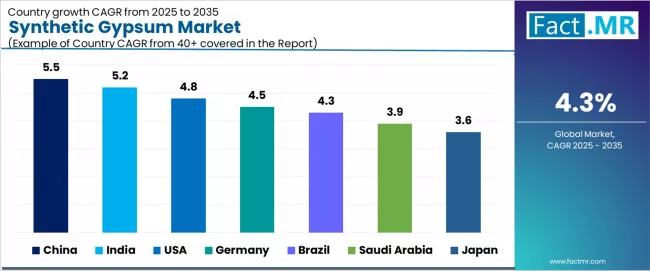
| Country | CAGR (2025 to 2035) |
|---|---|
| China | 5.5% |
| India | 5.2% |
| USA | 4.8% |
| Germany | 4.5% |
| Brazil | 4.3% |
| Saudi Arabia | 3.9% |
| Japan | 3.6% |
The synthetic gypsum market is experiencing exceptional growth globally, with China leading at a 5.5% CAGR through 2035, driven by expanding construction industry scale, growing power generation infrastructure, and increasing environmental regulation enforcement across major industrial and urban centers. India follows at 5.2%, supported by massive infrastructure development programs, rising FGD system installations, and comprehensive construction material modernization initiatives. Brazil records 4.3% growth, benefiting from construction sector expansion and growing environmental compliance requirements.
USA demonstrates 4.8% growth, emphasizing sustainable construction material adoption and green building certification expansion. Germany shows 4.5% growth with construction industry excellence and environmental standards leadership focus. Saudi Arabia records 3.9% growth, representing construction sector development and industrial diversification initiatives, while Japan shows 3.6% growth, representing advanced construction standards and material quality emphasis.
How does China Demonstrate Exceptional Market Potential with Expanding Construction Industry?
Revenue from synthetic gypsum in China is projected to exhibit exceptional growth with a CAGR of 5.5% through 2035, driven by the world's largest construction industry and increasing adoption of environmental compliance technologies as an essential component for industrial sustainability and building material supply enhancement. The country's massive infrastructure development programs and growing availability of FGD gypsum sources are creating significant opportunities for synthetic gypsum deployment across both residential construction and commercial building segments.
Major international construction material manufacturers and domestic producers are establishing comprehensive processing facilities to serve the expanding population of building contractors and wallboard manufacturers requiring sustainable material sources across urban development projects, industrial construction, and residential markets throughout China's diverse construction regions.
The Chinese government's strategic emphasis on environmental protection and sustainable development is driving substantial investments in FGD system installations and material recovery capabilities. This policy support, combined with the country's enormous construction market and growing sustainability awareness, creates a favorable environment for synthetic gypsum market development. Chinese construction material manufacturers are increasingly focusing on domestic material sourcing to improve supply chain reliability, with synthetic gypsum representing a key component in this resource optimization.
- Government initiatives supporting environmental compliance and circular economy principles are driving demand for synthetic gypsum across construction and industrial segments
- Construction capacity expansion and sustainable building practices are supporting appropriate utilization of synthetic gypsum among manufacturers and construction material facilities nationwide
- Building contractors and material manufacturers are increasingly recognizing environmental benefits in construction material sourcing, creating new sustainability capabilities
- Rising construction material investment and growing awareness of resource efficiency benefits are accelerating synthetic gypsum adoption across application categories
What makes India Demonstrate Market Leadership with Infrastructure Development Programs?
Revenue from synthetic gypsum in India is expanding at a CAGR of 5.2%, supported by aggressive infrastructure development initiatives, rapidly expanding construction industry, and advancing environmental regulation integration across the country's developing urban and rural corridors.
The country's massive building programs and increasing sophistication of power generation platforms are driving demand for sustainable gypsum sources in both construction and cement applications. International construction material providers and domestic manufacturers are establishing processing capacity to serve the growing demand for quality synthetic gypsum while supporting the country's position as a leading construction market.
India's construction sector continues to benefit from favorable government policies, developing material supply infrastructure, and growing industry willingness to adopt sustainable materials. The country's focus on expanding environmental compliance capabilities is driving investments in critical FGD technologies and material recovery systems. This development is particularly important for synthetic gypsum applications, as manufacturers seek reliable material sources to enhance production sustainability and reduce dependence on natural gypsum mining.
- Rising awareness about environmental sustainability and improving domestic material recovery capabilities are creating opportunities for synthetic gypsum solutions
- Growing construction activity and power generation modernization are supporting increased deployment of gypsum recovery systems across industrial categories
- Expanding environmental regulation enforcement and emerging sustainability standards are driving innovative applications of synthetic gypsum in construction and cement applications
- Material recovery capability advancement is enabling delivery of consistent quality materials, supporting market growth and reducing natural resource extraction requirements
Why does Brazil Maintain Construction Market Leadership?
Revenue from synthetic gypsum in Brazil is projected to exhibit strong growth with a CAGR of 4.3% through 2035, driven by expanding construction operations and developing environmental compliance sector. The country's position as a leading Latin American construction market and growing industrial infrastructure are creating significant opportunities for synthetic gypsum integration across both building material and cement manufacturing applications.
Brazilian construction material manufacturers are leveraging industrial expertise to serve the growing demand for sustainable material sources while supporting the country's position as a major regional construction economy.
The market benefits from strong construction sector fundamentals supporting building material demand, enabling optimized material sourcing and comprehensive sustainability integration. This development is particularly important for synthetic gypsum applications, as manufacturers seek cost-effective material solutions that maximize production efficiency while ensuring environmental compliance in construction material and cement production environments.
Strategic Market Considerations:
- Construction sector expansion and infrastructure development programs leading growth with focus on sustainable material sourcing and building product quality applications
- Economic development and growing environmental awareness are driving diverse synthetic gypsum portfolios from basic material recovery to advanced processing platforms
- Construction industry expertise and material supply capabilities supporting competitive positioning in Latin American markets
- Environmental regulations and sustainability requirements beginning to influence material specifications and adoption timelines
How does USA Maintain Sustainable Construction Material Leadership?
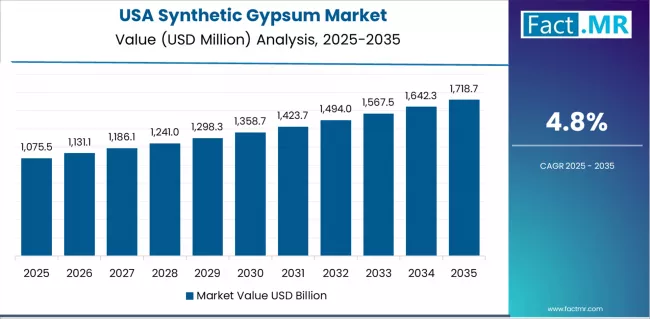
USA's advanced construction market demonstrates sophisticated synthetic gypsum deployment with documented effectiveness in green building platforms and sustainable construction applications through integration with environmental compliance technologies and quality assurance protocols. The country leverages construction industry leadership and comprehensive sustainability standards to maintain a 4.8% CAGR through 2035.
Construction material manufacturers, including major wallboard producers in key manufacturing regions and integrated building material companies, showcase advanced synthetic gypsum implementations where consistent material quality integrates with comprehensive environmental programs and ongoing sustainability initiatives to optimize production efficiency and environmental performance.
American construction material manufacturers prioritize sustainability and material consistency in production operations, creating demand for premium synthetic gypsum sources with reliable quality, including consistent material specifications and integration with comprehensive quality management systems. The market benefits from established FGD infrastructure and willingness to invest in advanced processing technologies that provide superior material consistency and compliance with stringent construction material standards and environmental expectations.
Strategic Market Considerations:
- Drywall and cement segments leading growth with focus on sustainable material sourcing and comprehensive quality system applications
- High environmental standards are driving sophisticated material portfolios from standard gypsum applications to advanced specialty product platforms
- Construction industry sustainability leadership and green building emphasis supporting continued innovation in synthetic gypsum utilization
- Material specifications and quality requirements ensuring consistent material performance and production optimization
What drives Germany’s Market Growth with Construction Industry Excellence?
Germany's expanding synthetic gypsum market demonstrates accelerating material adoption with a 4.5% CAGR through 2035, driven by construction industry excellence, comprehensive environmental regulations, and sophisticated material quality standards across major building material regions.
The country's leadership in sustainable construction and environmental compliance is creating substantial demand for synthetic gypsum solutions across diverse building product and construction material platforms. The construction material manufacturers and processing facilities are increasingly prioritizing synthetic gypsum sources that incorporate proven quality protocols for optimal production outcomes and sustainability enhancement.
Market dynamics focus on high-quality synthetic gypsum materials that balance consistent performance with environmental considerations important to the construction industry standards and sustainability requirements. Growing domestic material recovery expertise creates opportunities for integrated processing programs and advanced quality control deployment.
Strategic Market Considerations:
- Construction material and building product segments leading growth with focus on quality consistency and sustainable sourcing applications
- Diverse material requirements are driving varied synthetic gypsum portfolios from conventional drywall applications to specialized construction material platforms
- Quality optimization supported by extensive construction industry expertise and environmental compliance excellence
- Material manufacturer preferences emphasizing proven performance and comprehensive quality validation in synthetic gypsum applications
How does Saudi Arabia demonstrate Construction Sector Development?
Saudi Arabia's expanding synthetic gypsum market demonstrates accelerating material adoption with a 3.9% CAGR through 2035, driven by construction sector diversification, infrastructure development programs, and growing industrial capacity across major economic development regions.
The country's emphasis on economic transformation and construction industry expansion is creating demand for building material solutions including synthetic gypsum across diverse infrastructure and commercial building platforms. Saudi construction material manufacturers and building product facilities are increasingly prioritizing sustainable material sources that support economic diversification objectives.
Market dynamics focus on reliable synthetic gypsum materials that balance material availability with quality considerations important to construction industry development and infrastructure project requirements. Growing domestic construction capacity creates opportunities for material supply development and processing capability advancement.
Strategic Market Considerations:
- Infrastructure and commercial construction segments demonstrating focused growth with emphasis on material reliability and construction project applications
- Development requirements driving building material specifications with consistent quality characteristics and project timeline optimization
- Construction sector expansion supported by economic diversification initiatives and infrastructure investment programs
- Material supply development emphasizing availability assurance and quality consistency in construction applications
What drives Japan’s Market Growth with Construction Quality Standards?
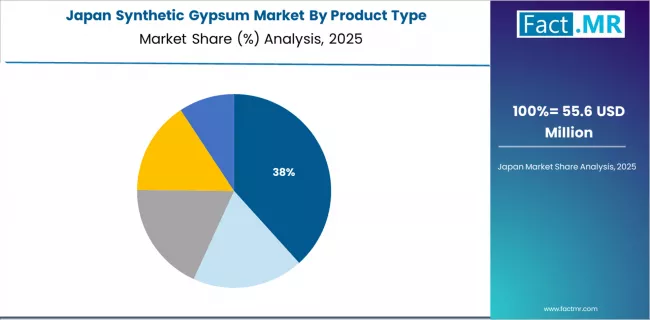
Japan's expanding synthetic gypsum market demonstrates accelerating material adoption with a 3.6% CAGR through 2035, driven by advanced construction quality standards, precision manufacturing methodologies, and comprehensive material specification protocols across major building material regions.
The country's emphasis on construction excellence and meticulous quality control is creating substantial demand for consistent synthetic gypsum solutions across diverse residential and commercial construction platforms. Japanese construction material manufacturers and wallboard producers are increasingly prioritizing synthetic gypsum sources that incorporate precision material specifications for optimal quality outcomes and production reliability.
Market dynamics focus on high-quality synthetic gypsum materials that balance consistent performance with reliability considerations important to Japanese construction standards and long-term building quality requirements. Growing domestic material processing expertise creates opportunities for integrated quality excellence programs and advanced material consistency deployment.
- Residential construction and commercial building segments demonstrating focused growth with emphasis on quality precision and comprehensive material specification applications
- High-quality requirements driving premium synthetic gypsum specifications with consistent material characteristics and production outcome optimization
- Construction excellence supported by building material industry expertise and precision manufacturing capabilities
- Material manufacturer preferences emphasizing proven reliability and comprehensive quality validation in construction material applications
Europe Market Split by Country
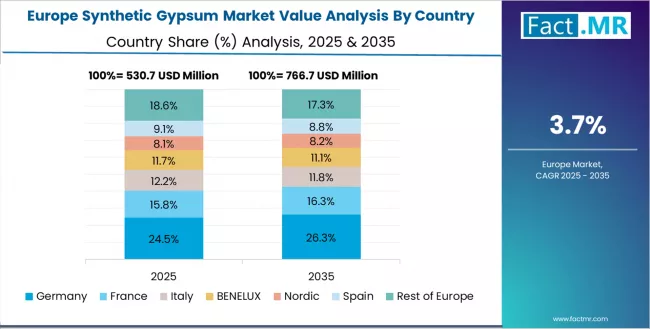
The synthetic gypsum market in Europe is projected to grow from USD 0.5 billion in 2025 to USD 1.1 billion by 2035, registering a CAGR of 4.2% over the forecast period. Germany is expected to maintain its leadership position with a 32.8% market share in 2025, rising to 33.5% by 2035, supported by its dominant construction material manufacturing infrastructure, comprehensive environmental regulation framework, and advanced FGD system installations throughout major industrial facilities and power generation networks.
France follows with a 22.4% share in 2025, projected to reach 23.1% by 2035, driven by construction industry development, environmental compliance emphasis, and expanding sustainable building material adoption serving both domestic and European markets. The United Kingdom holds a 18.6% share in 2025, expected to increase to 19.2% by 2035, supported by green building initiatives and construction material sustainability requirements. Italy commands a 14.2% share in 2025, projected to reach 13.8% by 2035, while Spain accounts for 9.5% in 2025, expected to reach 9.1% by 2035.
The rest of Europe region, including Nordic countries with advanced environmental standards, Eastern European emerging markets, and smaller Western European construction material centers, is anticipated to hold 2.5% in 2025, declining slightly to 1.3% by 2035, attributed to market consolidation toward larger core markets with established material processing infrastructure and synthetic gypsum supply expertise.
Competitive Landscape of the Synthetic Gypsum Market
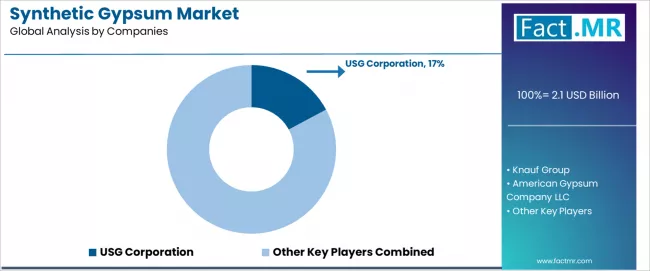
The synthetic gypsum market is characterized by intense competition among established construction material manufacturers, integrated wallboard producers, and specialized gypsum processing organizations focused on delivering high-quality, reliable, and cost-effective synthetic gypsum solutions.
Companies are investing in processing technology advancement, quality control system enhancement, strategic supply partnerships, and comprehensive technical support initiatives to deliver effective, efficient, and reliable synthetic gypsum materials that meet stringent construction material standards and manufacturer expectations. Material consistency, quality assurance emphasis, and production reliability strategies are central to strengthening product portfolios and market presence.
USG Corporation leads the market with a 17.2% market share, offering comprehensive synthetic gypsum solutions with a focus on wallboard manufacturing expertise and advanced material processing capabilities for construction applications. Knauf Group provides integrated building material platforms with emphasis on sustainable sourcing and comprehensive quality management across global construction markets.
Saint-Gobain focuses on diversified construction material portfolios and comprehensive building product solutions serving international construction communities. National Gypsum Company delivers specialized wallboard manufacturing with strong production capabilities and material consistency emphasis.
BNBM Group operates with a focus on large-scale construction material production and synthetic gypsum utilization for diverse building applications. Georgia-Pacific Gypsum LLC provides integrated wallboard manufacturing services emphasizing production efficiency and material quality capabilities.
American Gypsum Company LLC specializes in regional construction material supply and comprehensive building product support with emphasis on market accessibility. Dolina Nidy Sp.z.o.o delivers specialized gypsum processing expertise to enhance material availability and provide consistent quality solutions. Yoshino Gypsum Co. Ltd. and Etex Group focus on specialized regional construction material services and building product solutions, emphasizing material quality and comprehensive processing protocols through dedicated manufacturing strategies.
Key Players in the Synthetic Gypsum Market
- USG Corporation
- Knauf Group
- American Gypsum Company LLC
- Saint-Gobain
- National Gypsum Company
- BNBM Group
- Georgia-Pacific Gypsum LLC
- Dolina Nidy Sp.z.o.o
- Yoshino Gypsum Co. Ltd.
- Etex Group
Scope of the Report
| Items | Values |
|---|---|
| Quantitative Units (2025) | USD 2.1 Billion |
| Product Type | FGD Gypsum, Fluorogypsum, Phosphogypsum, Citrogypsum, Others |
| Application | Drywall, Cement, Soil Amendments, Others |
| Regions Covered | Asia Pacific, North America, Europe, Latin America, Middle East & Africa |
| Countries Covered | USA, Germany, UK, Japan, India, China, Brazil and 40+ countries |
| Key Companies Profiled | USG Corporation, Knauf Group, American Gypsum Company LLC, Saint-Gobain, National Gypsum Company, BNBM Group, Georgia-Pacific Gypsum LLC, Dolina Nidy Sp.z.o.o, Yoshino Gypsum Co. Ltd., Etex Group |
| Additional Attributes | Dollar sales by product type, application, regional demand trends, competitive landscape, construction material manufacturer preferences for specific synthetic gypsum sources, integration with comprehensive building material systems, innovations in processing technology development, quality control advancement, and production efficiency optimization capabilities |
Synthetic Gypsum Market by Segments
-
Product Type :
- FGD Gypsum
- Fluorogypsum
- Phosphogypsum
- Citrogypsum
- Others
-
Application :
- Drywall
- Cement
- Soil Amendments
- Others
-
Region :
-
Asia Pacific
- China
- India
- Japan
- South Korea
- ASEAN
- Australia & New Zealand
- Rest of Asia Pacific
-
North America
- United States
- Canada
- Mexico
-
Europe
- Germany
- France
- United Kingdom
- Italy
- Spain
- Nordic
- BENELUX
- Rest of Europe
-
Latin America
- Brazil
- Argentina
- Chile
- Rest of Latin America
-
Middle East & Africa
- Kingdom of Saudi Arabia
- Other GCC Countries
- Turkey
- South Africa
- Other African Countries
- Rest of Middle East & Africa
-
Table of Content
- Executive Summary
- Global Market Outlook
- Demand to side Trends
- Supply to side Trends
- Technology Roadmap Analysis
- Analysis and Recommendations
- Market Overview
- Market Coverage / Taxonomy
- Market Definition / Scope / Limitations
- Market Background
- Market Dynamics
- Drivers
- Restraints
- Opportunity
- Trends
- Scenario Forecast
- Demand in Optimistic Scenario
- Demand in Likely Scenario
- Demand in Conservative Scenario
- Opportunity Map Analysis
- Product Life Cycle Analysis
- Supply Chain Analysis
- Investment Feasibility Matrix
- Value Chain Analysis
- PESTLE and Porter’s Analysis
- Regulatory Landscape
- Regional Parent Market Outlook
- Production and Consumption Statistics
- Import and Export Statistics
- Market Dynamics
- Global Market Analysis 2020 to 2024 and Forecast, 2025 to 2035
- Historical Market Size Value (USD Million) Analysis, 2020 to 2024
- Current and Future Market Size Value (USD Million) Projections, 2025 to 2035
- Y to o to Y Growth Trend Analysis
- Absolute $ Opportunity Analysis
- Global Market Pricing Analysis 2020 to 2024 and Forecast 2025 to 2035
- Global Market Analysis 2020 to 2024 and Forecast 2025 to 2035, By Product Type
- Introduction / Key Findings
- Historical Market Size Value (USD Million) Analysis By Product Type, 2020 to 2024
- Current and Future Market Size Value (USD Million) Analysis and Forecast By Product Type, 2025 to 2035
- FGD Gypsum
- Fluorogypsum
- Phosphogypsum
- Citrogypsum
- Others
- Y to o to Y Growth Trend Analysis By Product Type, 2020 to 2024
- Absolute $ Opportunity Analysis By Product Type, 2025 to 2035
- Global Market Analysis 2020 to 2024 and Forecast 2025 to 2035, By Application
- Introduction / Key Findings
- Historical Market Size Value (USD Million) Analysis By Application, 2020 to 2024
- Current and Future Market Size Value (USD Million) Analysis and Forecast By Application, 2025 to 2035
- Drywall
- Cement
- Soil Amendments
- Others
- Y to o to Y Growth Trend Analysis By Application, 2020 to 2024
- Absolute $ Opportunity Analysis By Application, 2025 to 2035
- Global Market Analysis 2020 to 2024 and Forecast 2025 to 2035, By Region
- Introduction
- Historical Market Size Value (USD Million) Analysis By Region, 2020 to 2024
- Current Market Size Value (USD Million) Analysis and Forecast By Region, 2025 to 2035
- North America
- Latin America
- Western Europe
- Eastern Europe
- East Asia
- South Asia and Pacific
- Middle East & Africa
- Market Attractiveness Analysis By Region
- North America Market Analysis 2020 to 2024 and Forecast 2025 to 2035, By Country
- Historical Market Size Value (USD Million) Trend Analysis By Market Taxonomy, 2020 to 2024
- Market Size Value (USD Million) Forecast By Market Taxonomy, 2025 to 2035
- By Country
- USA
- Canada
- Mexico
- By Product Type
- By Application
- By Country
- Market Attractiveness Analysis
- By Country
- By Product Type
- By Application
- Key Takeaways
- Latin America Market Analysis 2020 to 2024 and Forecast 2025 to 2035, By Country
- Historical Market Size Value (USD Million) Trend Analysis By Market Taxonomy, 2020 to 2024
- Market Size Value (USD Million) Forecast By Market Taxonomy, 2025 to 2035
- By Country
- Brazil
- Chile
- Rest of Latin America
- By Product Type
- By Application
- By Country
- Market Attractiveness Analysis
- By Country
- By Product Type
- By Application
- Key Takeaways
- Western Europe Market Analysis 2020 to 2024 and Forecast 2025 to 2035, By Country
- Historical Market Size Value (USD Million) Trend Analysis By Market Taxonomy, 2020 to 2024
- Market Size Value (USD Million) Forecast By Market Taxonomy, 2025 to 2035
- By Country
- Germany
- UK
- Italy
- Spain
- France
- Nordic
- BENELUX
- Rest of Western Europe
- By Product Type
- By Application
- By Country
- Market Attractiveness Analysis
- By Country
- By Product Type
- By Application
- Key Takeaways
- Eastern Europe Market Analysis 2020 to 2024 and Forecast 2025 to 2035, By Country
- Historical Market Size Value (USD Million) Trend Analysis By Market Taxonomy, 2020 to 2024
- Market Size Value (USD Million) Forecast By Market Taxonomy, 2025 to 2035
- By Country
- Russia
- Poland
- Hungary
- Balkan & Baltic
- Rest of Eastern Europe
- By Product Type
- By Application
- By Country
- Market Attractiveness Analysis
- By Country
- By Product Type
- By Application
- Key Takeaways
- East Asia Market Analysis 2020 to 2024 and Forecast 2025 to 2035, By Country
- Historical Market Size Value (USD Million) Trend Analysis By Market Taxonomy, 2020 to 2024
- Market Size Value (USD Million) Forecast By Market Taxonomy, 2025 to 2035
- By Country
- China
- Japan
- South Korea
- By Product Type
- By Application
- By Country
- Market Attractiveness Analysis
- By Country
- By Product Type
- By Application
- Key Takeaways
- South Asia and Pacific Market Analysis 2020 to 2024 and Forecast 2025 to 2035, By Country
- Historical Market Size Value (USD Million) Trend Analysis By Market Taxonomy, 2020 to 2024
- Market Size Value (USD Million) Forecast By Market Taxonomy, 2025 to 2035
- By Country
- India
- ASEAN
- Australia & New Zealand
- Rest of South Asia and Pacific
- By Product Type
- By Application
- By Country
- Market Attractiveness Analysis
- By Country
- By Product Type
- By Application
- Key Takeaways
- Middle East & Africa Market Analysis 2020 to 2024 and Forecast 2025 to 2035, By Country
- Historical Market Size Value (USD Million) Trend Analysis By Market Taxonomy, 2020 to 2024
- Market Size Value (USD Million) Forecast By Market Taxonomy, 2025 to 2035
- By Country
- Kingdom of Saudi Arabia
- Other GCC Countries
- Turkiye
- South Africa
- Other African Union
- Rest of Middle East & Africa
- By Product Type
- By Application
- By Country
- Market Attractiveness Analysis
- By Country
- By Product Type
- By Application
- Key Takeaways
- Key Countries Market Analysis
- USA
- Pricing Analysis
- Market Share Analysis, 2024
- By Product Type
- By Application
- Canada
- Pricing Analysis
- Market Share Analysis, 2024
- By Product Type
- By Application
- Mexico
- Pricing Analysis
- Market Share Analysis, 2024
- By Product Type
- By Application
- Brazil
- Pricing Analysis
- Market Share Analysis, 2024
- By Product Type
- By Application
- Chile
- Pricing Analysis
- Market Share Analysis, 2024
- By Product Type
- By Application
- Germany
- Pricing Analysis
- Market Share Analysis, 2024
- By Product Type
- By Application
- UK
- Pricing Analysis
- Market Share Analysis, 2024
- By Product Type
- By Application
- Italy
- Pricing Analysis
- Market Share Analysis, 2024
- By Product Type
- By Application
- Spain
- Pricing Analysis
- Market Share Analysis, 2024
- By Product Type
- By Application
- France
- Pricing Analysis
- Market Share Analysis, 2024
- By Product Type
- By Application
- India
- Pricing Analysis
- Market Share Analysis, 2024
- By Product Type
- By Application
- ASEAN
- Pricing Analysis
- Market Share Analysis, 2024
- By Product Type
- By Application
- Australia & New Zealand
- Pricing Analysis
- Market Share Analysis, 2024
- By Product Type
- By Application
- China
- Pricing Analysis
- Market Share Analysis, 2024
- By Product Type
- By Application
- Japan
- Pricing Analysis
- Market Share Analysis, 2024
- By Product Type
- By Application
- South Korea
- Pricing Analysis
- Market Share Analysis, 2024
- By Product Type
- By Application
- Russia
- Pricing Analysis
- Market Share Analysis, 2024
- By Product Type
- By Application
- Poland
- Pricing Analysis
- Market Share Analysis, 2024
- By Product Type
- By Application
- Hungary
- Pricing Analysis
- Market Share Analysis, 2024
- By Product Type
- By Application
- Kingdom of Saudi Arabia
- Pricing Analysis
- Market Share Analysis, 2024
- By Product Type
- By Application
- Turkiye
- Pricing Analysis
- Market Share Analysis, 2024
- By Product Type
- By Application
- South Africa
- Pricing Analysis
- Market Share Analysis, 2024
- By Product Type
- By Application
- USA
- Market Structure Analysis
- Competition Dashboard
- Competition Benchmarking
- Market Share Analysis of Top Players
- By Regional
- By Product Type
- By Application
- Competition Analysis
- Competition Deep Dive
- USG Corporation
- Overview
- Product Portfolio
- Profitability by Market Segments (Product/Age /Sales Channel/Region)
- Sales Footprint
- Strategy Overview
- Marketing Strategy
- Product Strategy
- Channel Strategy
- Knauf Group
- American Gypsum Company LLC
- Saint-Gobain
- National Gypsum Company
- BNBM Group
- Georgia-Pacific Gypsum LLC
- Dolina Nidy Sp.z.o.o
- Yoshino Gypsum Co. Ltd.
- Etex Group
- USG Corporation
- Competition Deep Dive
- Assumptions & Acronyms Used
- Research Methodology
List Of Table
- Table 1: Global Market Value (USD Million) Forecast by Region, 2020 to 2035
- Table 2: Global Market Value (USD Million) Forecast by Product Type, 2020 to 2035
- Table 3: Global Market Value (USD Million) Forecast by Application, 2020 to 2035
- Table 4: North America Market Value (USD Million) Forecast by Country, 2020 to 2035
- Table 5: North America Market Value (USD Million) Forecast by Product Type, 2020 to 2035
- Table 6: North America Market Value (USD Million) Forecast by Application, 2020 to 2035
- Table 7: Latin America Market Value (USD Million) Forecast by Country, 2020 to 2035
- Table 8: Latin America Market Value (USD Million) Forecast by Product Type, 2020 to 2035
- Table 9: Latin America Market Value (USD Million) Forecast by Application, 2020 to 2035
- Table 10: Western Europe Market Value (USD Million) Forecast by Country, 2020 to 2035
- Table 11: Western Europe Market Value (USD Million) Forecast by Product Type, 2020 to 2035
- Table 12: Western Europe Market Value (USD Million) Forecast by Application, 2020 to 2035
- Table 13: Eastern Europe Market Value (USD Million) Forecast by Country, 2020 to 2035
- Table 14: Eastern Europe Market Value (USD Million) Forecast by Product Type, 2020 to 2035
- Table 15: Eastern Europe Market Value (USD Million) Forecast by Application, 2020 to 2035
- Table 16: East Asia Market Value (USD Million) Forecast by Country, 2020 to 2035
- Table 17: East Asia Market Value (USD Million) Forecast by Product Type, 2020 to 2035
- Table 18: East Asia Market Value (USD Million) Forecast by Application, 2020 to 2035
- Table 19: South Asia and Pacific Market Value (USD Million) Forecast by Country, 2020 to 2035
- Table 20: South Asia and Pacific Market Value (USD Million) Forecast by Product Type, 2020 to 2035
- Table 21: South Asia and Pacific Market Value (USD Million) Forecast by Application, 2020 to 2035
- Table 22: Middle East & Africa Market Value (USD Million) Forecast by Country, 2020 to 2035
- Table 23: Middle East & Africa Market Value (USD Million) Forecast by Product Type, 2020 to 2035
- Table 24: Middle East & Africa Market Value (USD Million) Forecast by Application, 2020 to 2035
List Of Figures
- Figure 1: Global Market Pricing Analysis
- Figure 2: Global Market Value (USD Million) Forecast 2020 to 2035
- Figure 3: Global Market Value Share and BPS Analysis by Product Type, 2025 and 2035
- Figure 4: Global Market Y to o to Y Growth Comparison by Product Type, 2025 to 2035
- Figure 5: Global Market Attractiveness Analysis by Product Type
- Figure 6: Global Market Value Share and BPS Analysis by Application, 2025 and 2035
- Figure 7: Global Market Y to o to Y Growth Comparison by Application, 2025 to 2035
- Figure 8: Global Market Attractiveness Analysis by Application
- Figure 9: Global Market Value (USD Million) Share and BPS Analysis by Region, 2025 and 2035
- Figure 10: Global Market Y to o to Y Growth Comparison by Region, 2025 to 2035
- Figure 11: Global Market Attractiveness Analysis by Region
- Figure 12: North America Market Incremental Dollar Opportunity, 2025 to 2035
- Figure 13: Latin America Market Incremental Dollar Opportunity, 2025 to 2035
- Figure 14: Western Europe Market Incremental Dollar Opportunity, 2025 to 2035
- Figure 15: Eastern Europe Market Incremental Dollar Opportunity, 2025 to 2035
- Figure 16: East Asia Market Incremental Dollar Opportunity, 2025 to 2035
- Figure 17: South Asia and Pacific Market Incremental Dollar Opportunity, 2025 to 2035
- Figure 18: Middle East & Africa Market Incremental Dollar Opportunity, 2025 to 2035
- Figure 19: North America Market Value Share and BPS Analysis by Country, 2025 and 2035
- Figure 20: North America Market Value Share and BPS Analysis by Product Type, 2025 and 2035
- Figure 21: North America Market Y to o to Y Growth Comparison by Product Type, 2025 to 2035
- Figure 22: North America Market Attractiveness Analysis by Product Type
- Figure 23: North America Market Value Share and BPS Analysis by Application, 2025 and 2035
- Figure 24: North America Market Y to o to Y Growth Comparison by Application, 2025 to 2035
- Figure 25: North America Market Attractiveness Analysis by Application
- Figure 26: Latin America Market Value Share and BPS Analysis by Country, 2025 and 2035
- Figure 27: Latin America Market Value Share and BPS Analysis by Product Type, 2025 and 2035
- Figure 28: Latin America Market Y to o to Y Growth Comparison by Product Type, 2025 to 2035
- Figure 29: Latin America Market Attractiveness Analysis by Product Type
- Figure 30: Latin America Market Value Share and BPS Analysis by Application, 2025 and 2035
- Figure 31: Latin America Market Y to o to Y Growth Comparison by Application, 2025 to 2035
- Figure 32: Latin America Market Attractiveness Analysis by Application
- Figure 33: Western Europe Market Value Share and BPS Analysis by Country, 2025 and 2035
- Figure 34: Western Europe Market Value Share and BPS Analysis by Product Type, 2025 and 2035
- Figure 35: Western Europe Market Y to o to Y Growth Comparison by Product Type, 2025 to 2035
- Figure 36: Western Europe Market Attractiveness Analysis by Product Type
- Figure 37: Western Europe Market Value Share and BPS Analysis by Application, 2025 and 2035
- Figure 38: Western Europe Market Y to o to Y Growth Comparison by Application, 2025 to 2035
- Figure 39: Western Europe Market Attractiveness Analysis by Application
- Figure 40: Eastern Europe Market Value Share and BPS Analysis by Country, 2025 and 2035
- Figure 41: Eastern Europe Market Value Share and BPS Analysis by Product Type, 2025 and 2035
- Figure 42: Eastern Europe Market Y to o to Y Growth Comparison by Product Type, 2025 to 2035
- Figure 43: Eastern Europe Market Attractiveness Analysis by Product Type
- Figure 44: Eastern Europe Market Value Share and BPS Analysis by Application, 2025 and 2035
- Figure 45: Eastern Europe Market Y to o to Y Growth Comparison by Application, 2025 to 2035
- Figure 46: Eastern Europe Market Attractiveness Analysis by Application
- Figure 47: East Asia Market Value Share and BPS Analysis by Country, 2025 and 2035
- Figure 48: East Asia Market Value Share and BPS Analysis by Product Type, 2025 and 2035
- Figure 49: East Asia Market Y to o to Y Growth Comparison by Product Type, 2025 to 2035
- Figure 50: East Asia Market Attractiveness Analysis by Product Type
- Figure 51: East Asia Market Value Share and BPS Analysis by Application, 2025 and 2035
- Figure 52: East Asia Market Y to o to Y Growth Comparison by Application, 2025 to 2035
- Figure 53: East Asia Market Attractiveness Analysis by Application
- Figure 54: South Asia and Pacific Market Value Share and BPS Analysis by Country, 2025 and 2035
- Figure 55: South Asia and Pacific Market Value Share and BPS Analysis by Product Type, 2025 and 2035
- Figure 56: South Asia and Pacific Market Y to o to Y Growth Comparison by Product Type, 2025 to 2035
- Figure 57: South Asia and Pacific Market Attractiveness Analysis by Product Type
- Figure 58: South Asia and Pacific Market Value Share and BPS Analysis by Application, 2025 and 2035
- Figure 59: South Asia and Pacific Market Y to o to Y Growth Comparison by Application, 2025 to 2035
- Figure 60: South Asia and Pacific Market Attractiveness Analysis by Application
- Figure 61: Middle East & Africa Market Value Share and BPS Analysis by Country, 2025 and 2035
- Figure 62: Middle East & Africa Market Value Share and BPS Analysis by Product Type, 2025 and 2035
- Figure 63: Middle East & Africa Market Y to o to Y Growth Comparison by Product Type, 2025 to 2035
- Figure 64: Middle East & Africa Market Attractiveness Analysis by Product Type
- Figure 65: Middle East & Africa Market Value Share and BPS Analysis by Application, 2025 and 2035
- Figure 66: Middle East & Africa Market Y to o to Y Growth Comparison by Application, 2025 to 2035
- Figure 67: Middle East & Africa Market Attractiveness Analysis by Application
- Figure 68: Global Market - Tier Structure Analysis
- Figure 69: Global Market - Company Share Analysis
- FAQs -
How big is the synthetic gypsum market in 2025?
The global synthetic gypsum market is estimated to be valued at USD 2.1 billion in 2025.
What will be the size of synthetic gypsum market in 2035?
The market size for the synthetic gypsum market is projected to reach USD 3.2 billion by 2035.
How much will be the synthetic gypsum market growth between 2025 and 2035?
The synthetic gypsum market is expected to grow at a 4.3% CAGR between 2025 and 2035.
What are the key product types in the synthetic gypsum market?
The key product types in synthetic gypsum market are fgd gypsum, fluorogypsum, phosphogypsum, citrogypsum and others.
Which application segment to contribute significant share in the synthetic gypsum market in 2025?
In terms of application, drywall segment to command 41.0% share in the synthetic gypsum market in 2025.